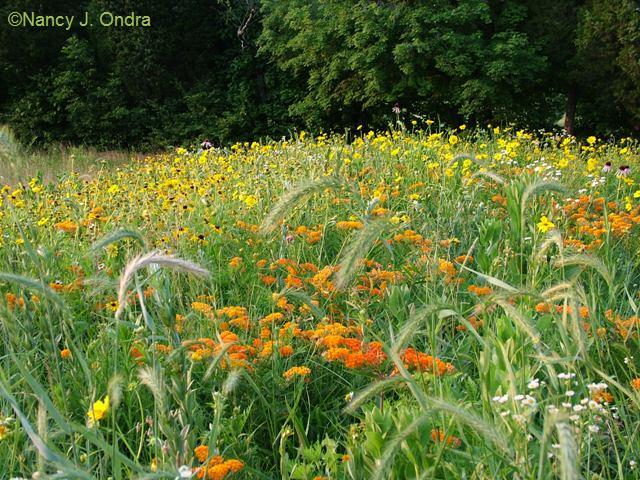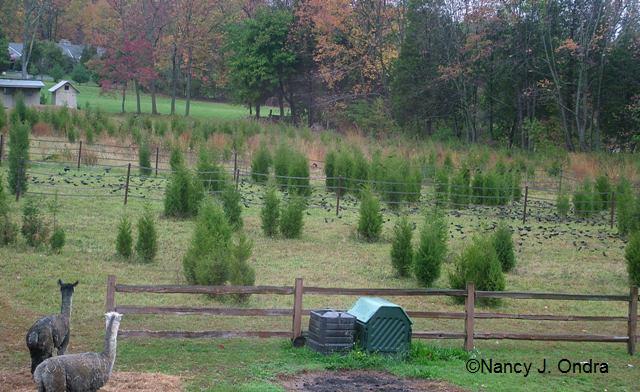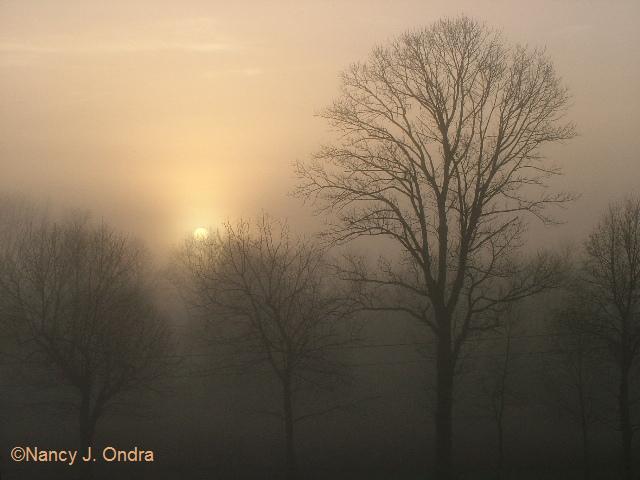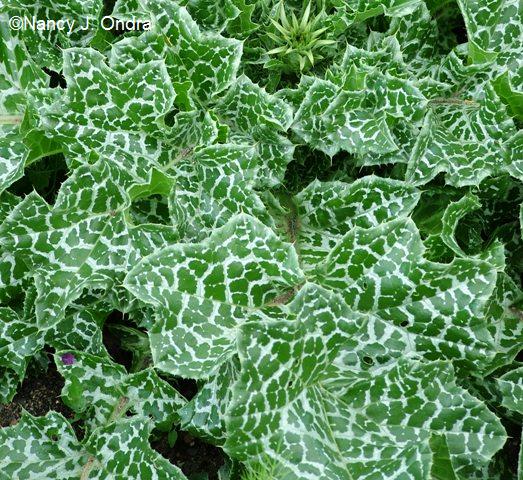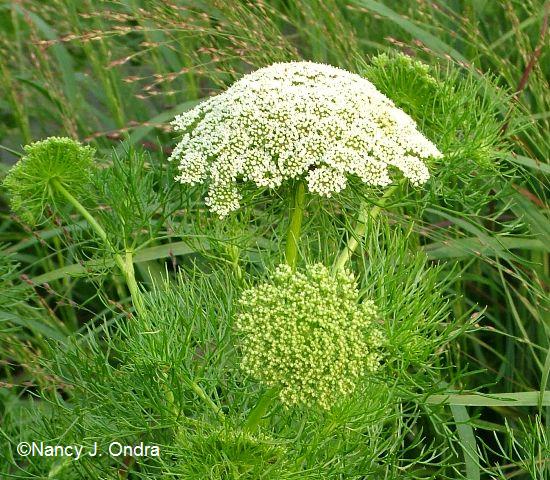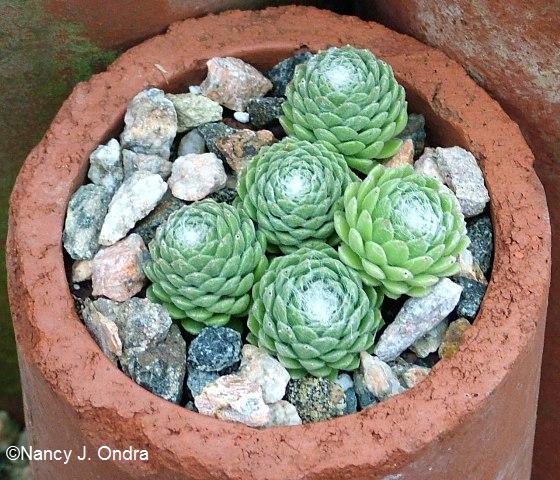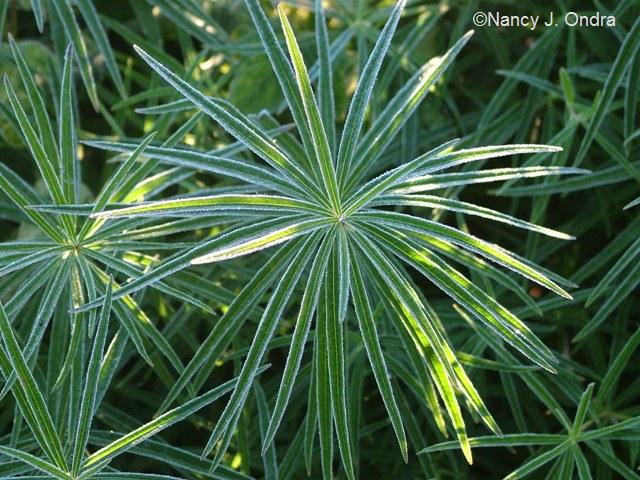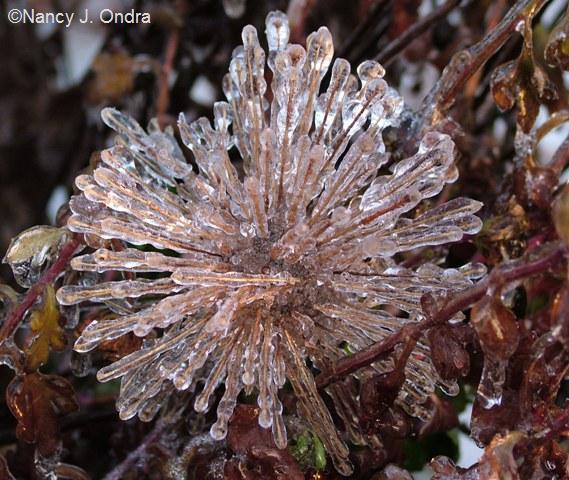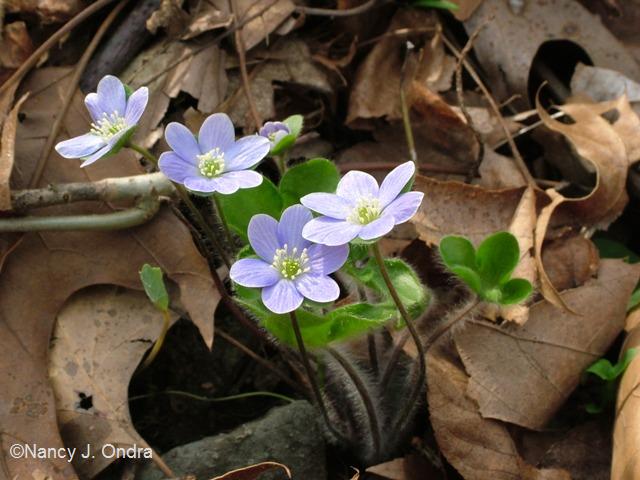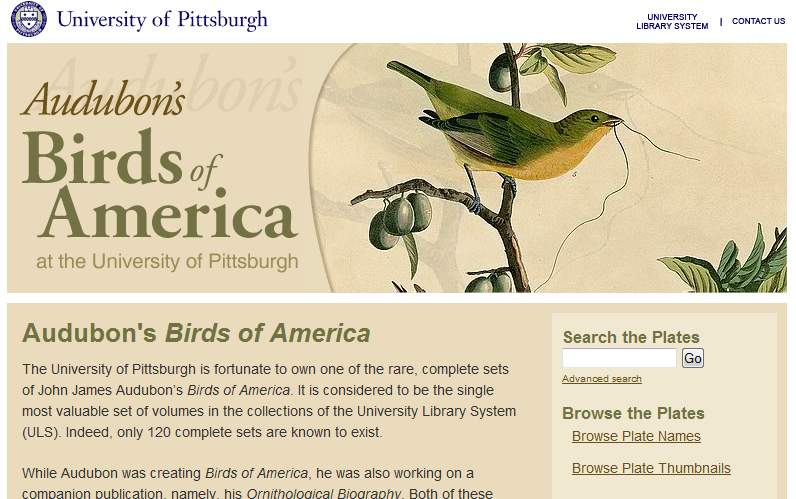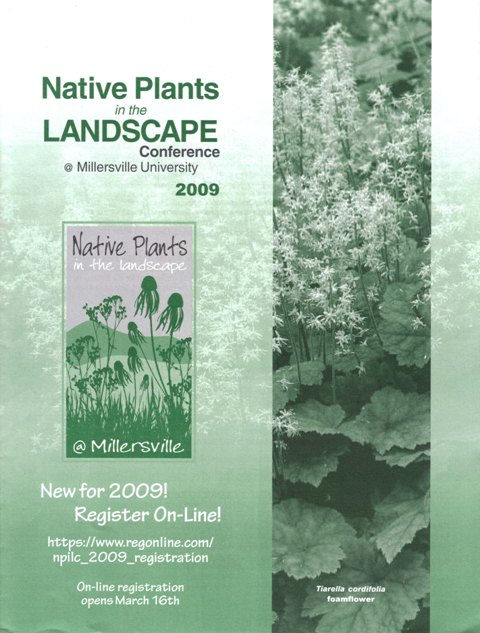 Finding time to get away during the growing season is almost impossible, but there’s one yearly event that I hate to miss: the Native Plants in the Landscape Conference held at Millersville University in Millersville, Pennsylvania. This year, rainy weather made the whole event more enjoyable, because I didn’t have to feel guilty about not being out in the garden or worry about plants not getting watered. Even if it had been perfect gardening weather, though, I wouldn’t have regretted a minute spent indoors, because the entire conference was packed with great speakers and events. I took lots of notes, and I thought I’d share some of the highlights. You know how challenging it can be to take notes in a dark room, so if there are mistakes in here, blame me and not the speakers. (Well, I suppose you could blame them for giving so much good information so quickly that I might have missed or misunderstood some stuff.) Warning: text-heavy post ahead.
Finding time to get away during the growing season is almost impossible, but there’s one yearly event that I hate to miss: the Native Plants in the Landscape Conference held at Millersville University in Millersville, Pennsylvania. This year, rainy weather made the whole event more enjoyable, because I didn’t have to feel guilty about not being out in the garden or worry about plants not getting watered. Even if it had been perfect gardening weather, though, I wouldn’t have regretted a minute spent indoors, because the entire conference was packed with great speakers and events. I took lots of notes, and I thought I’d share some of the highlights. You know how challenging it can be to take notes in a dark room, so if there are mistakes in here, blame me and not the speakers. (Well, I suppose you could blame them for giving so much good information so quickly that I might have missed or misunderstood some stuff.) Warning: text-heavy post ahead.
The King’s Garden: John Bartram of Philadelphia (Kirk Brown)
If you ever have the opportunity to see Kirk Brown’s portrayal of John Bartram, grab it! The costume, the dramatics, the history, and the humor: it was a perfect kick-off for the conference. It was interesting to learn how Bartram arranged his expeditions (some fairly close to home, and others as far off as Florida – possibly to escape his family of 9 children?), and find out about the kinds of plants that his supporters back in England were interested in (magnolias and pines, especially). Here’s a great article about Kirk channeling John Bartram: Bringing a Legendary Gardener Back to Life.
Nature’s Patterns in Art and Landscape Design (W. Gary Smith)
One of my favorite things about this conference is that it’s not just all natives, all the time. Each year, they slip in topics that broaden our education and increase our appreciation of issues and ideas beyond just our plants and gardens. I’ll admit that sometimes my mind isn’t open to those ideas at the moment, but they still make an impression, and the results often surprise me.
A few years ago, environmental artist Gary Smith spoke at the conference (can’t remember the subject now), and also held a workshop where the participants created a labyrinth using mini straw bales. I attended a different concurrent session so missed the construction, but we had to walk by the finished product many times on the way from the dorms and dining hall to the student center. At the time, I honestly thought the whole thing was a little odd and “new age-y”, but the memory of seeing a lone woman peacefully walking the labyrinth early one morning stuck with me.
When I got home, I decided to mow a labyrinth into my meadow. I never did find it all that meditative, unfortunately. Perhaps because it was so large and time was limited, I walked it quickly, sat in the chair in the middle for a middle or two, contemplated the sky or the ticks, and then hurried out again to do more work. Still, it was kind of fun to mow. Plus, it freaked out one of my neighbors who was exploring our aerial maps of our neighborhood on line and wandered over to find out if I knew there were weird patterns carved into my field (also visible here).
Now, on to this year: Gary Smith’s talk on observing patterns that occur in nature and finding ways to translate them into designing gardens and landscapes. My pictures don’t do justice to some of these concepts; I need to hunt out some new ones. Once you start looking for these patterns, you’ll see them everywhere.
Scattered (like the random heights of seedheads, or when petals or fruits drop off of a tree):
Mosaic (with multiple elements competing for space, creating clumps and gaps; examples included meadows and tidal pools):
Serpentine (like the curves of a snake: rivers are one example):
Naturalistic Drift (loose clumps of objects; especially common in plants that are dispersed by birds):
Dendritic (where objects branch and branch again, like trees and roots and rivers):
Crackle (like tree bark):
Spiral (a very strong design pattern; examples included fern fiddleheads, nautilus shells, weather patterns):
Radial (branching out in different directions from one point, like a daisy or some seedpods):
He also showed some examples of his art installations; very cool. I especially liked some of the work he did for Garden in the Woods in 2007. You can find pictures here and here. I also highly recommend checking out his web site: W. Gary Smith Design.
In Search of Elusive Treasures – Exploring for Native Plants (Rick Lewandowski)
Rick Lewandowski is Director of the Mount Cuba Center in Delaware. The plant list for his talk included over 30 species: some I knew and quite a few I’d never heard of before, including Georgia basil (Clinopodium georgianum) – which apparently is hardy in Delaware and quite a self-sower – and Alabama croton (Croton alabamensis). Some notes:
- Plants can survive in habitats that are less than ideal. But they’ll reproduce only where the growing conditions are just right. Perennials that we think of as “short lived” can be much more vigorous and long-lasting when growing in conditions they’re suited to. (A conclusion I can draw from this: If you’re getting self-sown seedlings from something, then you’ve got that plant in the right place.)
- It’s important to consider provenance (the place where the seed came from), especially with the lesser-known native species. If someone collects seed from one area and then distributes that seed or the resulting plants, people who don’t have luck growing it assume that the plant isn’t suited to their climate; they may not try it again, and they’ll tell others that it didn’t grow for them. It’s possible, though, that seed of the same species collected from a different part of its growing range might be more successful.
- Observing plants in their native habitats – studying the conditions they’re growing in and the other plants they growing with – is one of the best ways to figure out where it might thrive in your garden. But, when you’re trying lesser-known species and they’re not thriving where you think they ought to, consider trying them in a different site. Florida anise (Illicium floridanum), for instance, grows in full sun in the South, but in the mid-Atlantic, it performs better in some shade. That’s opposite of what many gardeners would expect. Turns out, though, that where the soil freezes, Florida anise’s evergreen leaves can scorch badly during the winter unless they’re getting some protection from sun and wind.
- Southern sugar maple (Acer floridanum; formerly A. barbatum) can be a good substitute for sugar maple (A. saccharum) in the mid-Atlantic. (Sugar maples are suffering due to increasing soil acidity, except in areas where the soils are derived from limestone.)
Nomenclature Changes for Native Plants: What Do You Mean, No More Asters? (Tim Block)
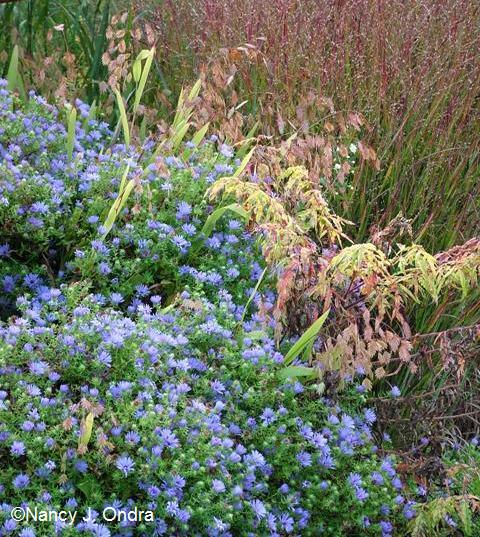 Dr. Block is Chair of Botany at the University of Pennsylvania’s Morris Arboretum in Philadelphia, Adjunct Professor of Biology at Penn, and Director of the Pennsylvania Flora Project. Some notes:
Dr. Block is Chair of Botany at the University of Pennsylvania’s Morris Arboretum in Philadelphia, Adjunct Professor of Biology at Penn, and Director of the Pennsylvania Flora Project. Some notes:
- There are still asters: It’s just that they’re not all Aster species. The European and Asian species are still in the genus Aster; the North American species have mostly been reclassified into several other genera. Most of the changes are a 1:1 correspondence (Aster divaricatus is now Eurybia divaricata; Aster novae-angliae is now Symphyotrichum novae-angliae), but a few have been separated into different varieties and subspecies, or even into different species.
- This is the first time I heard someone pronounce Symphyotrichum. I’m so glad I never said out loud how I’ve been saying it to myself. Now I know it’s something along the line of sim-fee-OT-trick-um.
- Much of the detail on the differences between the new aster genera left me grasping for my college botany knowledge. I kind of spaced out by the time we got to “the bracts of the phyllaries are not ciliate on the margins” (the diagnostic criterion for Symphyotrichum). It was good to hear that even Dr. Block still uses the old names in his field botany notes (then translates them when he gets back to his office).
- Not surprisingly, someone brought up the issue that gardeners are encouraged to use botanical names instead of common names because botanical names are “always the same,” but yet they change. That brought out a lot of sympathetic groans and chuckles from the audience, and from me too. I don’t think the resulting discussion pointed out, though, that while one plant can have several botanical names, those monikers all apply to one thing. With common names, on the other hand, one name can be used for several very different plants.
- So, why are all of these changes happening, anyway? I found out that when I took taxonomy 20 years ago, the system I learned was based on the work of William Conquist and focused on morphological (structural) characteristics. The “problem” with that kind of system is that different scientists could look at the same information and come up with different classifications. Now, the prevailing system is “cladistics,” which derived from the work of an entomologist named Willi Henning. It is heavily based on DNA testing and statistics, which makes it more computer-based than field-based.
- Best quote: “An aster by any other name still looks like an aster.” – Tim Block, 2009
- A whole hour spent on asters, and we didn’t even have time to get into other changes. Apparently the family Liliaceae has been exploded too; some of its members aren’t even in the lily family anymore. And that’s just the beginning. The phrase “…which used to be known as…” came up frequently in lectures and conversations throughout the conference. (Hepatica is now Anemone; Isopyrum is now Enemion; and on and on.)
Birds and Native Plants in Audubon Art and Audubon Yards (Stephen Saffier and Mitch Harper)
For the evening session, we were treated to yet another visit from a historical character: John James Audubon. “JJ” was a bit less intense than “John Bartram” (from where I was sitting, he looked somewhat like Howard Stern with slightly shorter hair, which was very amusing), but it was still quite interesting. For instance, I wasn’t aware that Audubon only did the bird parts of the art, working with three different illustrators for the plants. The differences were noticeable when we saw examples of each style, though. All of the artwork has been digitized now (you can browse through all of the plates at Audubon’s Birds of America at the University of Pittsburgh), and when you zoom in, you can sometimes see where the plants and birds overlap.
It was also great to find out about Audubon at Home, which has lots of resources for creating good bird habitat, as well as the Audubon Birdscapes blog. And, for those of us who live in Pennsylvania (and a few nearby states that don’t have their own Audubon chapter), there’s a new Audubon Pennsylvania Bird Habitat Recognition Program. In many ways, it’s like the National Wildlife Federation’s Certified Wildlife Habitat (“The Other Program”), but there’s more emphasis on the use of native plants, and – not surprisingly – on providing bird-friendly features. I applied online and am awaiting the arrival of my spiffy Audubon Bird Habitat sign, which will join my NWF sign at the end of my driveway.
Another cool feature I learned about through the application process was eBird, where you can easily keep lists of the birds you’ve observed in your yard and view information provided by other birders in your state, including maps of where specific birds were seen, when they were observed, and how many were reported. I don’t consider myself a birder, but I found the site fascinating, and I plan to start keeping my own eBird list soon.
Okay, well, that was just the first day, so I’m going to split this into two posts. Part Two is coming soon!



